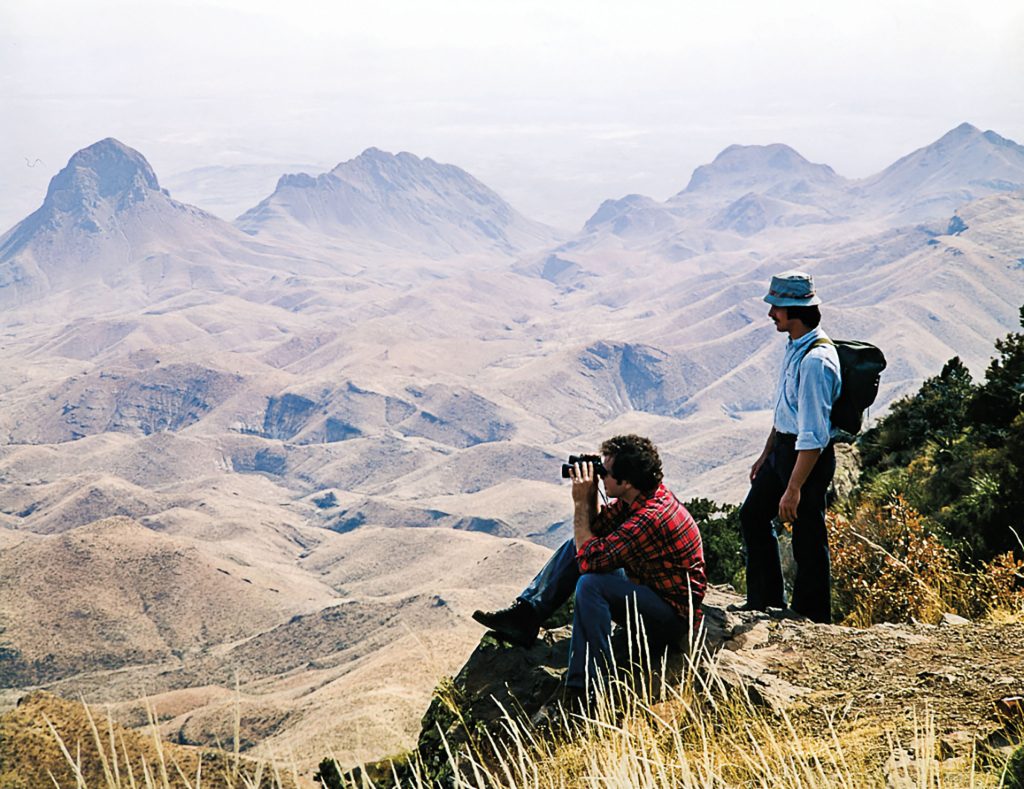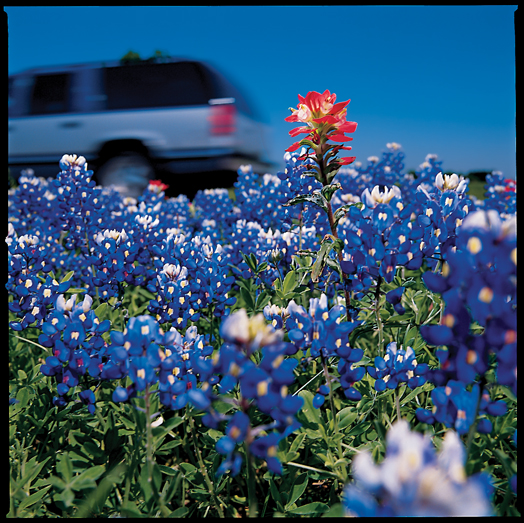
Wildflowers along Texas 71 near Ellinger. (Photo by J. Griffis Smith)
For the enlightened and adventurous traveler, serendipity transforms every trip: Hiking a new trail and rounding a bend to encounter an unexpected vista, journeying to a destination you’ve heard about—or visiting a familiar place with someone who’s never been—without an agenda. Or, in the case of pursuing Texas wildflowers, finding yourself surprised with the splashes and brushstrokes of red, blue, orange, and purple that appear in the landscape.
From year to year, nature’s wildflower displays vary dramatically. Rainfall (or lack there–of), the timing of the first freeze, the length of warm spells-—all these weather-related factors determine the palette in each spring’s bloom. And human actions, such as mowing, irrigation, and development, also play a role.
In any given year, wildflowers will bloom—some time, some place—in Texas. When, where, and in exactly what types and quantities—well, finding the answer to that question creates the thrill of the chase. We’ve selected four driving routes that, based on the predictions of experts at the Lady Bird Johnson Wildflower Center, should offer some of this year’s best wildflower viewing (we selected for variety, too). We also provided a compelling selection of roadside stops, places to stay, and other attractions, so you’ll have fun on your road trip no matter what. Meanwhile, keep your eyes open everywhere you go. When you see that first bluebonnet, you’ll know it’s spring.
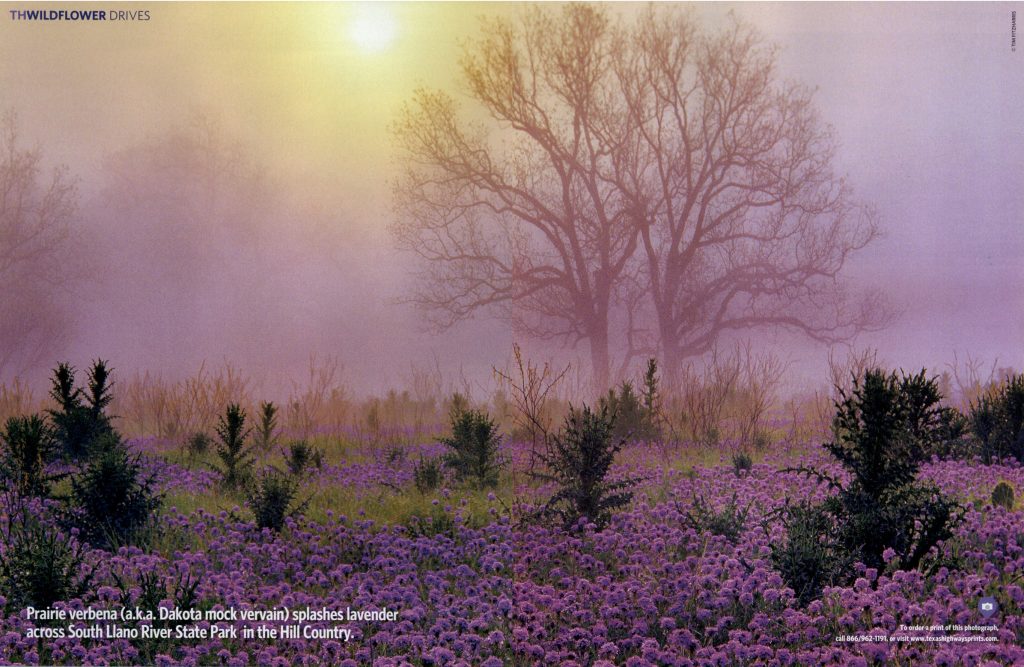
Photo by Tim Fitzharris
Brenham/Chappell Hill
Set aside a few hours to enjoy this 90-mile drive that scrawls a rough figure-8 around the Brenham area in Washington County. Start from Brenham and head northeast on Texas 105 through rolling hills, pastures, stands of oaks, and blooming flowers such as purple coneflower, verbena, beardtongue, coral bean, skullcaps, and prairie parsley. A few miles from the city limits, look off to the right for the Monastery Miniature Horse Farm, where the Franciscan Poor Clare nuns maintain a herd of cute, waist-high horses. The farm is worth a stop (Tue.-Sat., 1:30-4; open Fri.-Sat. only in Jan., Feb., and Sep.) to see ponies grazing amongst the colorful wildflowers. After a peek at the monastery’s gift shop, continue on Texas 105 and turn right on FM 1155.
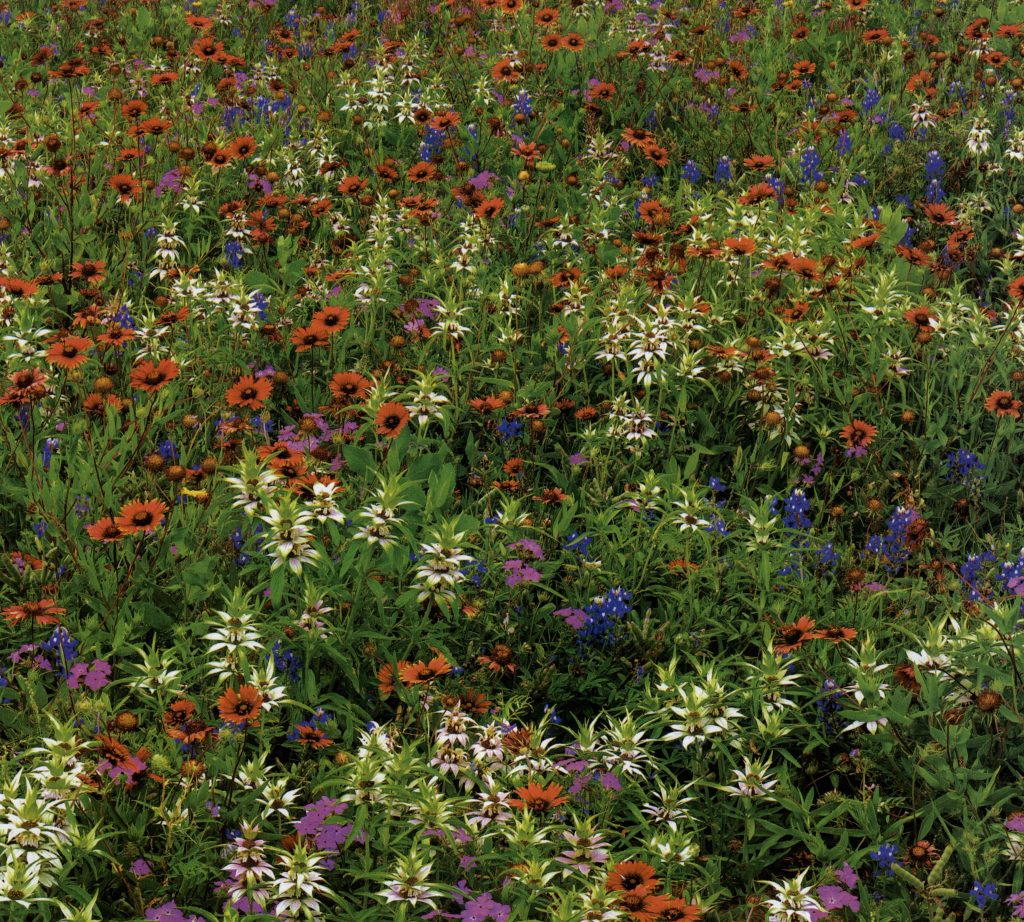
White splashes of spotted beebalm punctuate a sprawl of phlox and Indian blanket in San Saba County. (Photo by Richard Reynolds)
If you’re in no hurry, visit Washington-on-the-Brazos State Historic Site, home of the Star of the Republic Museum and Barrington Living History Farm. However, be forewarned. You’d need an entire day to do it justice. Because wildflowers rule this excursion, hustle back to scenic, flower-lined FM 1155. If you feel like slowing down, though, this stretch offers a halfdozen B&Bs to tempt you into extending the tour. Southern Rose Ranch, on Dairy Farm Road, serves breakfast on an outdoor stone patio; horses and belted Galloway cattle graze just across a cedar fence.
Drive slowly down the single street that passes through Chappell Hill’s quaint business district. Turn right at US 290 and take the Austin exit in Brenham to remain on 290 roughly 14 miles to the turn-off for Burton, FM 1697. Pay attention, because this stretch of highway often provides some of the lushest bluebonnet spreads in the entire state. Also look for Indian paintbrush, yellow wild indigo, thistles, blue-eyed grass, rattlesnake flower, blanket flower, and rosinweed.
When you get to Burton, look for Knittel Homestead Inn on Main, which offers another chance to extend your wildflower tour, with six rooms in two houses and porches that beg to be lingered upon. At least, stop and check out the on-premise antiques shop, then turn right onto FM 390 for a winding trip through more scenic country and flowers.
In Independence, stop in Old Baylor Park on the side of the road. Site of the original Baylor University, the park now boasts excellent bluebonnet photo ops. Other usual suspects rounded up here include primroses, lyre leaf sage, prairie Brazos mint, and mayhaw trees. Turn right on FM 50, which takes you back to Texas 105 and Brenham.
Downtown Brenham offers several options for midday dining. Try a salad or soup at Funky Art Cafe, or stop at Must Be Heaven Sandwich Shoppe for a sandwich followed by a scoop of Blue Bell. You can stay for the night, too: One lovely spot is the Historic Ant Street Inn, which offers 15 rooms furnished in period antiques. Have your ice cream straight from the source with a tour of the nearby Blue Bell Creameries. Or, take a short detour back toward Chappell Hill and south on Nicholson Lake Road and stretch your legs at Texas Ranch Life, a working ranch with eight historic accommodations.
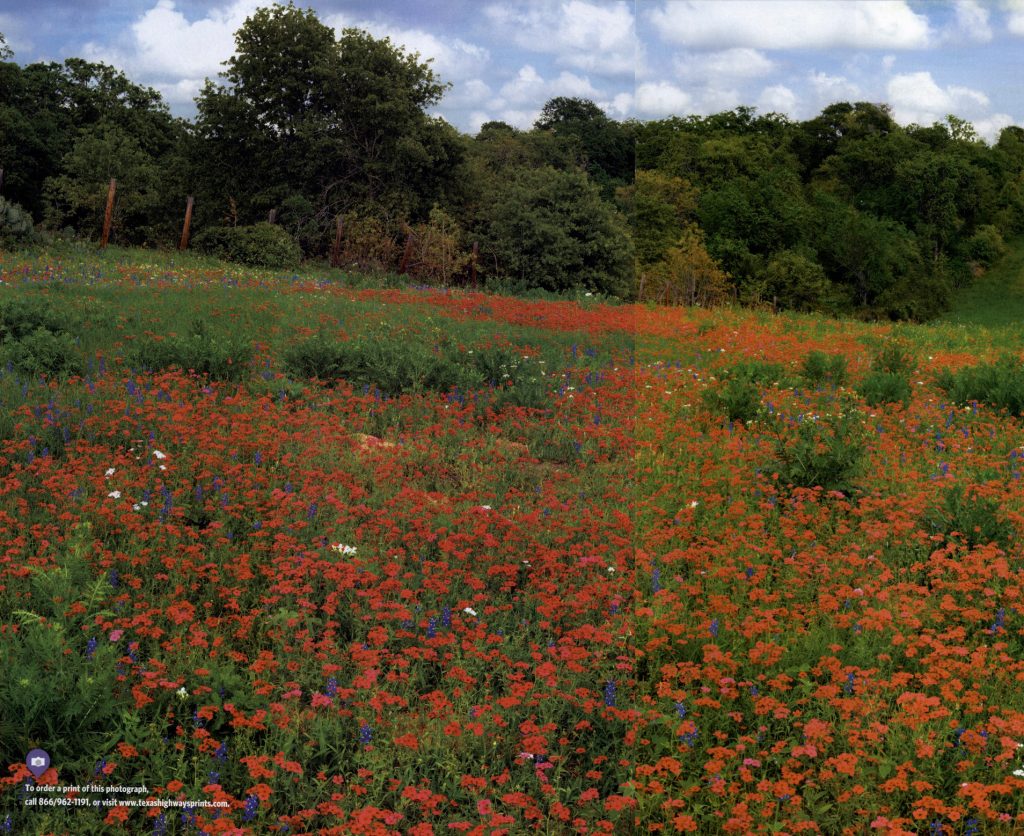
Bluebonnets dot a carpet of red Drummond phlox in Caldwell County. (Photo by Richard Reynolds)
Big Bend
This rough and winding route puts many miles on your vehicle, but the visual treats will prove more than enough reward. You’ll start in Terlingua; given its
remote location, you’ll want to arrive the day before and bunk at the cozy La Posada Milagro Guest House. Choose from four rooms created from stacked-rock ruins on a hilltop with incredible views of Big Bend National Park. Cook on the outdoor grill, or fuel up on spicy enchiladas, prickly pear margaritas, and live music at The Starlight Theatre, a short walk down the hill. Around town, look for blooming lyreleaf, jewelflower, and woody aster.
In the morning, take RM 170 west to the Barton Warnock Environmental Education Center, a source of information on points of interest along the scenic River Road, including Big Bend Ranch State Park. The Center’s herbarium houses 1,100 plant specimens discovered by noted Texas botanist Barton Warnock, plus exhibits on area geology, natural history, and a 2 ½-acre desert garden.
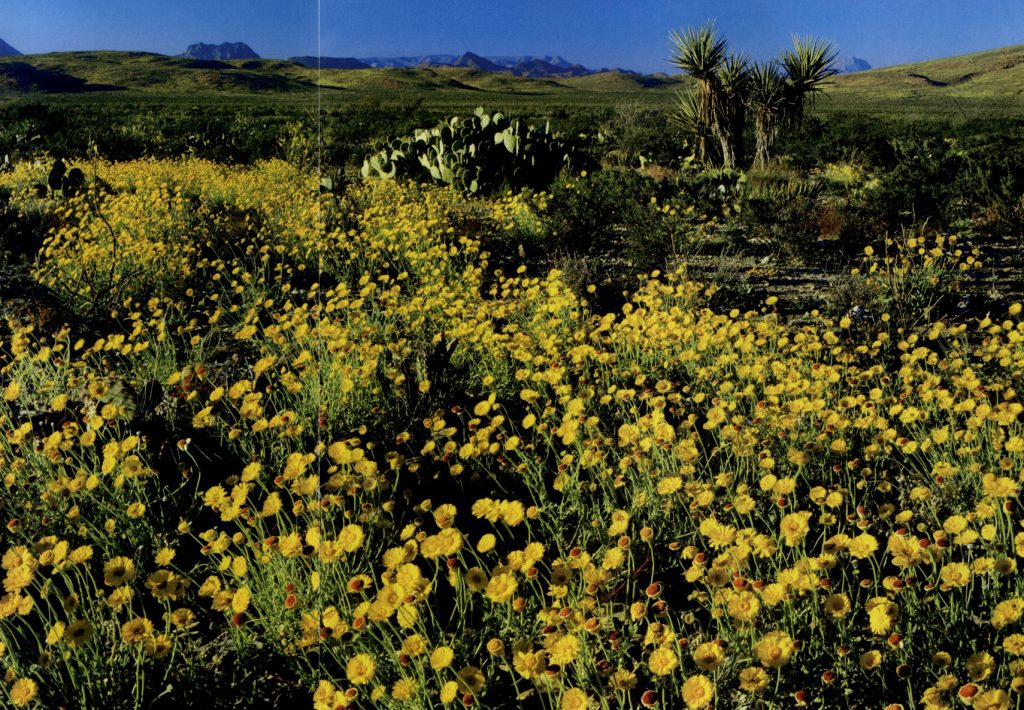
Desert marigolds in Big Bend National Park. (photo by Rolf Nussbumer)
Armed with knowledge, continue west toward Presidio. Look for blooming cacti, Big Bend bluebonnets, blind cactus, rainbow cactus, cat claw, strawberry pitaya, nama or fiddleleaf, bicolor fan mustard, ocotillo, cenizo, desert marigolds, and rock nettles. Stop to hike Closed Canyon, a narrow slot canyon, where you may spy hechtia, and the Rancherias Canyon Trail to observe unique riparian denizens, including marsh centaury. In Presidio, have some chicken enchiladas for lunch at La Escondida, then head north on US 67. In addition to wildflowers, look for herds of pronghorn antelope. If the breathtaking scenery seduces you, stop 33 miles south of Marfa at Cibolo Creek Ranch, where options include luxurious quarters in a restored 1800s hacienda—with a spa, pool, lake, and museum—or a secluded adobe cottage. Request a Jeep tour to see wildflower stands on the 30,000 acres, along with Native American sites, birds, and other wildlife.
Otherwise, continue to Marfa and grab a West Texas Mediterranean lunch at Food Shark (look for the diner truck under an awning between the bookstore and railroad tracks), or have dinner (deluxe chicken, steak, shrimp, trout, and pork tenderloin entrees, or a burger, along with exceptional appetizers and desserts) at Jett’s Grill in the Hotel Paisano. The drive on US 90 east to Alpine is dominated by grasslands where yucca and sotol bloom in the spring. In Alpine, have lunch or dinner at La Trattoria, celebrated for authentic Italian fare. If you decide to linger in Alpine, check into The Maverick Inn, a renovated historic motor court hotel. Enjoy a leisurely Mexican breakfast at Alicia’s, then turn on Texas 118 South back toward Terlingua. Along this scenic road, look for Mexican buckeyes and more wildflowers in the mid-elevations, and flowering desert scrub in lower areas. Fill up on traditional Chihuahuan Mexican food at the Chili Pepper Cafe near the Texas 118/RM 170 intersection. Finally, rest your weary wildflower watching bones in a cozy hillside cabin at Wildhorse Station in Study Butte, or at Terlingua’s Big Bend Motor Inn.
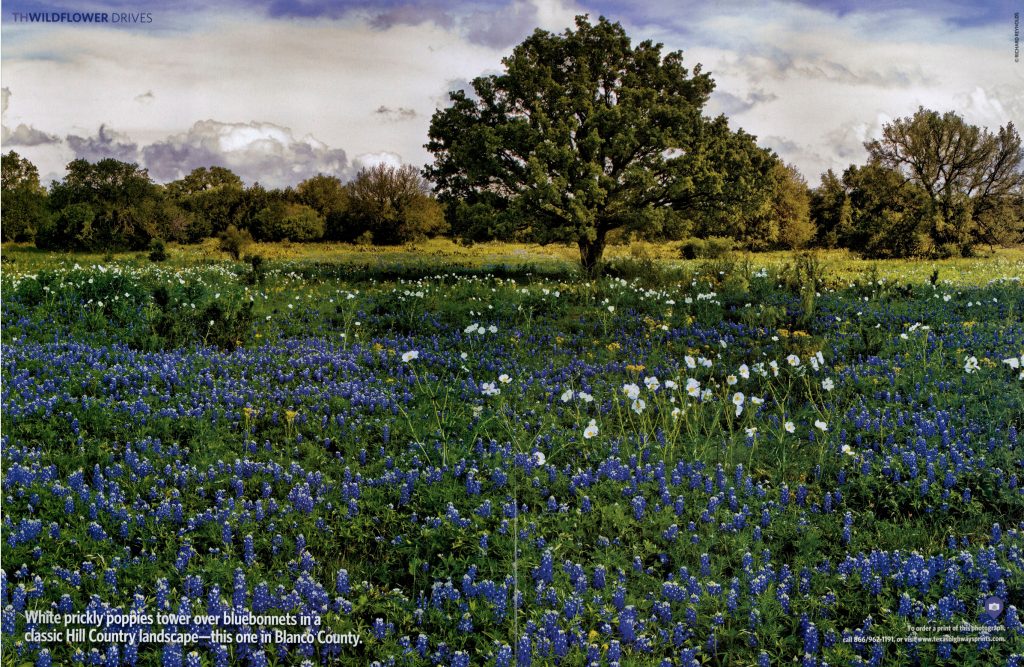
Photo by Richard Reynolds
Northeast Texas, Caddo Lake State Park, Cass County
You’ll begin and end this wildflower drive in Marshall, which offers numerous accommodations on US 59, including a handful of B&Bs. Head north along Texas 43 from Marshall to Karnack, and you may see bull thistle, coreopsis, and, at the edge of the woods, beardtongue. In low-lying areas, keep your eyes peeled for common rose mallow and giant coneflower, the latter with yellow blooms that can soar six feet high. Take FM 2198 to Uncertain, where crimson clover and coreopsis often bloom, along with partridge pea, downy phlox, bluebonnets, Mexican hats, and wild indigo.
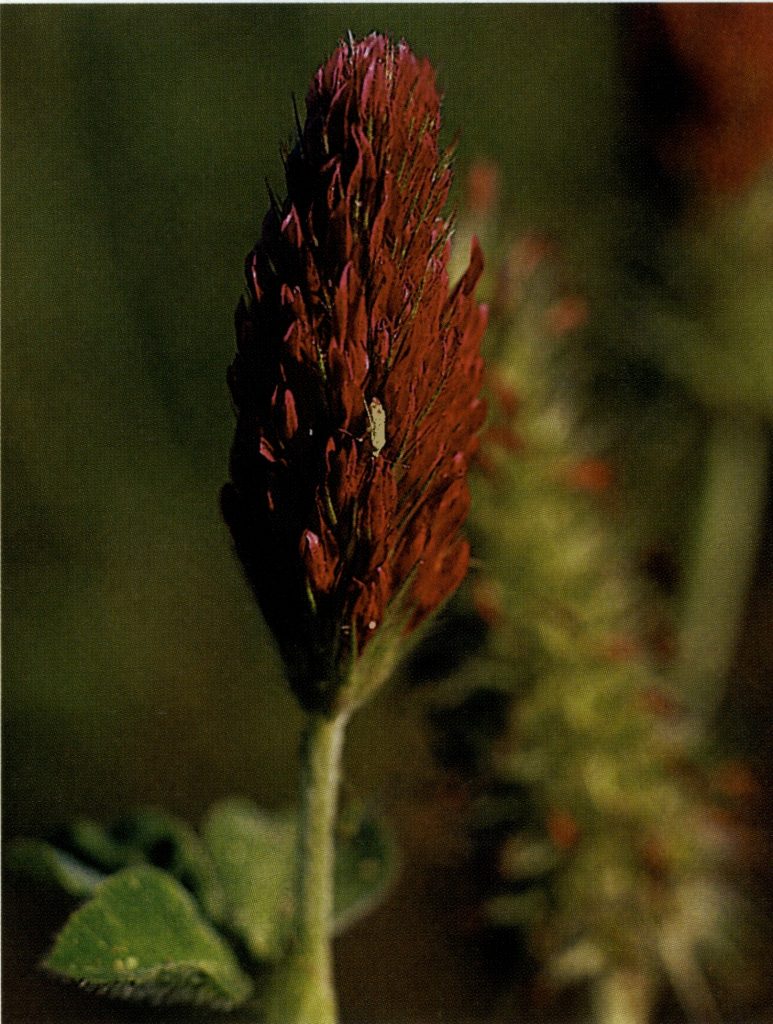
Crimson clover along a roadside near Ore City, north of Marshall and Longview. (Photo by J. Griffis Smith)
From Wednesday through Sunday, Crip’s Camp on the banks of Caddo Lake serves a hearty breakfast of sausage, eggs, toast, and hash browns. Or, if you get a late start, have lunch at Shady Glade, which also overlooks the lake; Shady Glade is known for homemade pie (open Thursday-Sunday). Heavily wooded Caddo Lake State Park curves around Saw Mill Pond and connects to Lake Caddo. On park trails, look for blooming Spanish moss; rent a canoe or kayak and paddle past floating bladderwort, blooming cabomba, fragrant water lily, and American lotus among the moss-shrouded bald cypress trees. If you’re having too much fun to leave, check into one of the park’s cabins, or book Hoot ‘N Holler Guest Cottage on the lake, or a landlocked house boat at Hodge Podge Cottages, both in Uncertain.
Make your way back to Texas 43 and continue north to Atlanta, then take US 59 to Linden. Along the way, look for coreopsis, crimson clover, spiderwort, phlox, and bachelor buttons gracing the landscape. Continue on Texas 155 to the tiny town of Avinger, then Texas 49 to Jefferson. A bustling port in the 1840s, Jefferson faded when the railroad arrived in Marshall, but you’ll find plenty of mansions turned B&Bs, as well as the historic Excelsior House and Jefferson Hotels, both famously haunted. Consider a bayou boat tour or a ride on a paddlewheel steamer on Caddo Lake, then treat yourself to French cuisine at the Stillwater Inn Restaurant. Or, to keep the pie theme going, visit House of Pies, then take US 59 back to Marshall. Other flowers likely to show themselves along this route include Indian paintbrush, larkspur, red buckeye, butterfly weed, and black-eyed Susans.
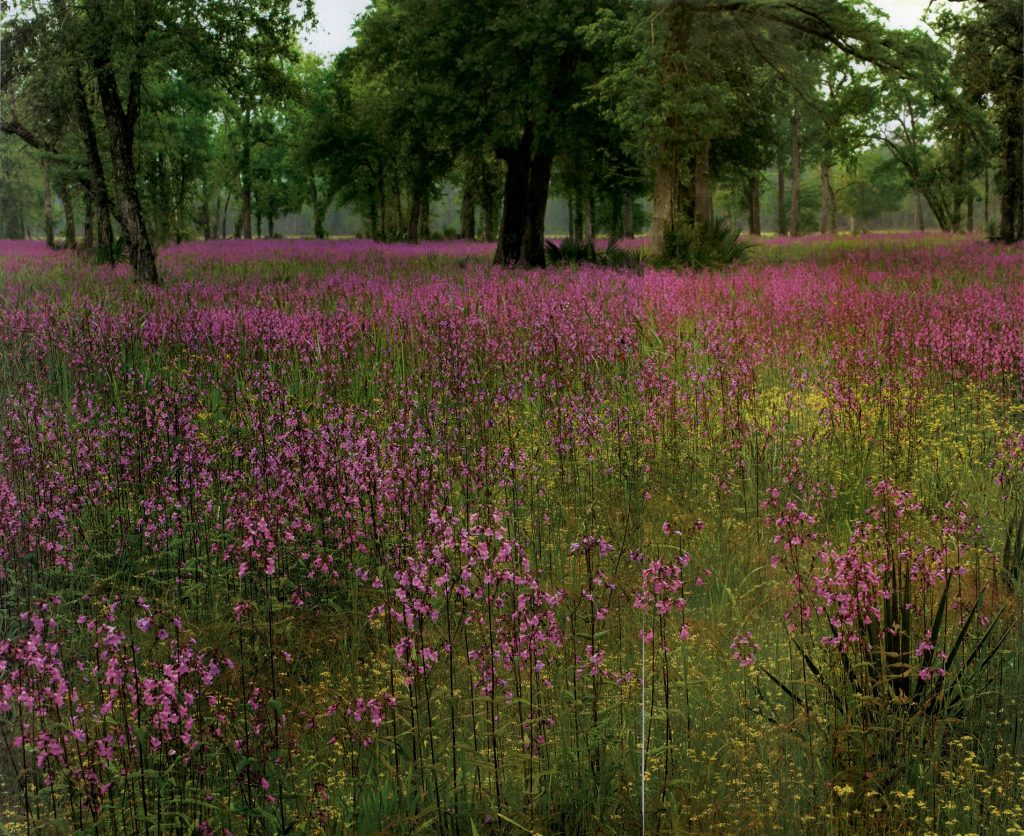
This spread of penstemon glorifies a wooded meadow in the Lance Rosier Unit of the Big Thicket Preserve in East Texas. (Photo by Tim Fitzharris)
Franklin Mountains
This route follows Loop 375, or the Trans-Mountain Road, through Franklin Mountains State Park, at 37 square miles, the nation’s largest urban park—all of it within El Paso’s city limits.
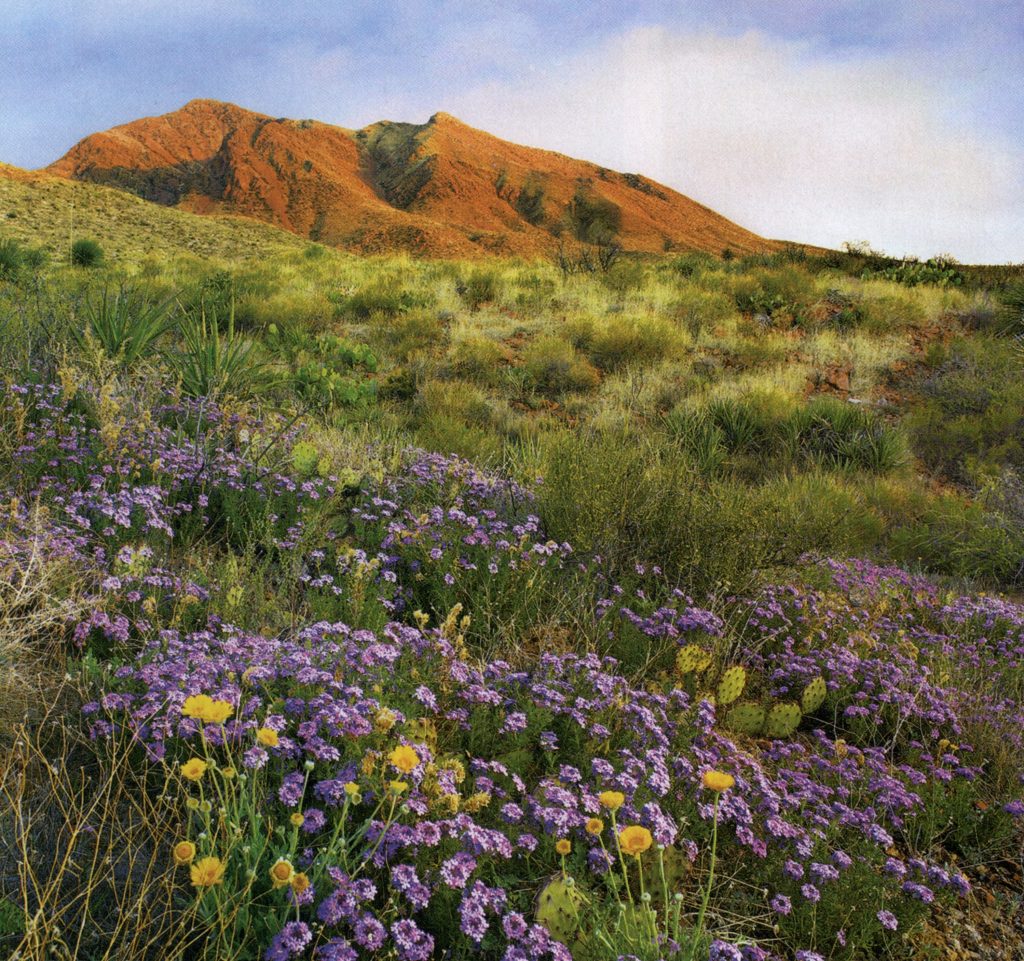
Lavender flowers of verbena join yellow desert marigolds clustering around prickly pear cactus in Franklin Mountains State Park in El Paso. (Photo by Tim Fitzharris)
To allow a full day for the drive, spend a night in the funky 1920s-era Gardner Hotel on nearby East Franklin Ave. or downtown in the more stately Camino Real Hotel. Built in 1912 and recently renovated, the elegant Camino Real is now listed in the National Register of Historic Places. Area dining options include Leo’s Mexican Food with three locations in El Paso, and the Little Diner and Tortilla Factory in Canutillo, all favorites with locals and restaurant critics. The staff at the Little Diner makes everything from scratch, even grinding corn for tortillas.
West of El Paso on Interstate 10, take the Canutillo/Trans-Mountain Road (Loop 375) exit and drive 3.8 miles to the park entrance. The Northern Chihuahuan Desert vegetation here includes lechuguilla, sotol, ocotillo, several types of yucca, and many cactus species. Some plant species found here, such as the Southwest barrel cactus, grow nowhere else in Texas. The Trans-Mountain Road reaches 5,120 feet elevation and passes the Ron Coleman Trail, a hike that affords up-close looks at blooming cacti. Fields of bright yellow mountain poppies, one of the park’s most spectacular sights, can best be seen on the eastern slope of the Franklins at the El Paso Museum of Archeology—providing, of course, the weather co-operates. Hike the short Sneed’s Cory trail in the Tom Mays Unit to see pineapple cactus, Chihuahuan fishhook cactus, and agave. This area offers additional trails, picnic sites, and primitive camping; the park also has RV sites. And, remember to visit the store located at park headquarters in McKelligon Canyon on the east side of the park.
For more dramatic and sweeping vistas, consider a ride on the Wyler Aerial Tramway. To get there, turn south on US 54, also known as Gateway Blvd., and then left on Fred Wilson Blvd., which becomes Alabama St. Follow Alabama to McKinley Ave., turn right and follow it to the park. The gondola ride takes four minutes and ends at 5,632-foot Ranger Peak, passing over a vast canyon, rock formations, and impressive cacti such as Arizona barrel cactus and claret cups. Take in the view of El Paso from here at 4,692 feet, and check out the cactus garden. An observation platform at the top affords 360-degree views of the park you just traversed, plus glimpses of three states and two countries. On the way back to town, satisfy your hunger at True Thai Restaurant, a Thai-owned eatery, or Bob’s Barbecue, both on Fred Wilson Blvd. If you have extra time and more appetite for cacti, drive east on US 62 and turn left on FM 2775 to Hueco Tanks State Historic Site. Here, large natural rock basins, or huecos, have furnished water for people passing through this region for millennia. Many left behind rock paintings, or pictographs, which you can see on guided tours Wednesday through Sunday. You won’t need guides to find cacti, as rainbow, pineapple, and several types of prickly pear prosper near the headquarters.
Many more amazing photos are featured in the print edition.
